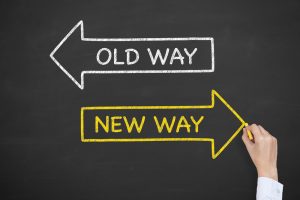Flexibility is a key that unlocks creativity, resilience, and happiness, allowing us to rebound when things don’t go as planned. And it’s something we can learn and enhance in ourselves. Without the ability to be flexible, you can be stumped when the one way you know how to accomplish something isn’t viable. For example, if you only know one route home but an accident blocks the road, you may think you have no option but to sit and wait, whereas someone who is more flexible might investigate back roads to find an alternate way home.
In the workplace, flexibility is integral for collaboration. A leader who has a rigid mindset will likely have trouble finding solutions that work for multiple parties. By being flexible and seeing beyond their own points of view, leaders can create synergies that help solve current challenges and strengthen relationships.
In physics, there is a principle of cybernetics that says the element in a system that has the most flexibility has the most influence. Imagine two tennis players: one has a terrific serve but a poor backhand. The other player doesn’t have one great skill but is good at many things, allowing her to be more flexible. She can hit the ball to her opponent’s backhand and win the point.
If you’ve found yourself relying on your terrific serve to address challenges, consider changing up your routine with fresh approaches. Start simple: If you normally put your socks on your right foot first, start with your left foot instead. Use your non-dominant hand for tasks like brushing your teeth or eating. Becoming flexible requires you to slow down and be more conscious of what you are doing, maybe even more present. But keep in mind that changing all your routines can be overwhelming, so start by doing just one or two things differently.
 Your unconscious routines may be the most difficult to change. For help, ask close co-workers, friends or family members to point out patterns they see you engaging in. A colleague might note, for instance, that no matter what solutions she offers for a problem, your first response is “no,” even though you typically change your mind later. Next time try responding, “Yes, and ….” If you always begin a conversation by sharing a story about yourself, ask about the other person first. Several clients have discovered that simply changing up how they begin conversations with their direct reports — either by leading with their own point of view or asking others to share theirs first — can have surprising positive results.
Your unconscious routines may be the most difficult to change. For help, ask close co-workers, friends or family members to point out patterns they see you engaging in. A colleague might note, for instance, that no matter what solutions she offers for a problem, your first response is “no,” even though you typically change your mind later. Next time try responding, “Yes, and ….” If you always begin a conversation by sharing a story about yourself, ask about the other person first. Several clients have discovered that simply changing up how they begin conversations with their direct reports — either by leading with their own point of view or asking others to share theirs first — can have surprising positive results.
Trying something new is a sure-fire way to increase flexibility. You might take a class on astronomy, join a local Meetup group for vintage car enthusiasts, or sign up with a cozy mystery book club. Making friends and learning different skills will bring new ideas and expand your possibilities. To stretch further, do something you wouldn’t typically do. If you often go to art museums, try a history or science museum. Look for ways to get new perspectives, such as talking with people who hold different viewpoints. If you can listen with a desire to understand and not feel compelled to argue, these conversations can be enlightening while increasing your flexibility.
As with changing a routine, it can take a while to appreciate the value of trying something new for newness’s sake. But don’t give up after just one attempt. Keep at it and you may discover you’re more flexible than you realized.

